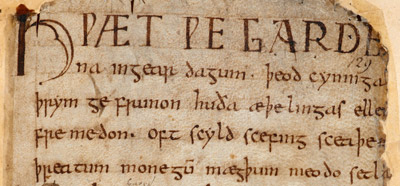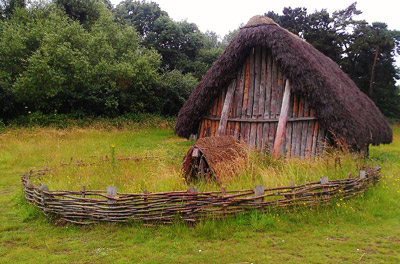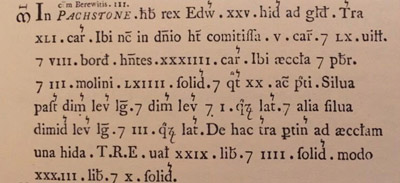Great Paxton in Saxon Times
Great Paxton arose as a Saxon village, if you are reading this in the village now, you are probably within 200 yards or less of where a Saxon household stood, maybe the remains are in your garden or your own house might even be on top of one.
The first thing you would notice if you were magicked back to England in Saxon times would be that everyone was speaking a language you couldn't understand - Old English.
Ƿes hāl, Hū
ᵹǣþ? Iċ hātte Paul, Ēadiᵹ, þeċ tō mētenne.
Old English
Wess haal,
hoo gath? Hoo haat-st thoo? Itch haht-teh Paul, May lee-koh-deh
thetch toe gray-ten-neh.
pronunciation
Hello, how
are you? My name is Paul, pleased to meet you.
translation
 Old
English is a language based on Anglo-Saxon but with a lot of influence
from native British languages such as Celtic and even the Latin
brought here by the Romans. In Great Paxton, the form of Old
English spoken would have been Mercian, named for the old kingdom
of Mercia of which we were a part before England was united,
more specifically we were at the eastern edge of Mercia known
as Middle Anglia. Old English was the first form of the English
language and lasted from the 6th or 7th centuries to about 1150
when it had developed into Middle English following the French
influences of the Normans after the conquest in 1066.
Old
English is a language based on Anglo-Saxon but with a lot of influence
from native British languages such as Celtic and even the Latin
brought here by the Romans. In Great Paxton, the form of Old
English spoken would have been Mercian, named for the old kingdom
of Mercia of which we were a part before England was united,
more specifically we were at the eastern edge of Mercia known
as Middle Anglia. Old English was the first form of the English
language and lasted from the 6th or 7th centuries to about 1150
when it had developed into Middle English following the French
influences of the Normans after the conquest in 1066.
The past is a foreign country, they do things differently there. - L.P. Hartley
The Great Ouse river valley has been inhabited for thousands of years. There were isolated farms and villas going back long before Roman times to the Iron Age. It is thought that the overall population density has been quite stable for a long time, though it was only with the Saxons that people began to move together to live in settlements such as arose to become our village. The population of Great Paxton has varied from about 200 to 450 from the first estimate we have from the Domesday Book in 1086 until the estate to the west of the High Street was built in the late 1970's and early 1980's, today it stands at just over 1,000.
Buildings at the West Stow Anglo-Saxon village in Suffolk. These are the sort of buildings that people would have lived in at Great Paxton during Saxon times, a hall on the left and ordinary house on the right.
There is very little recorded about the early history of the village. In times when the great majority of the population were illiterate, the history of the lives of ordinary folk was only recorded incidentally and has to be inferred from documents that record ownership, the value of land and other possessions or changes of power and governance.
The Anglo-Saxon period in Britain lasted from about 460 to 1066, ending with the Norman Conquest. In 1020 when building work began on the church, England was under Danish rule, King Cnut (Canute) was King of England and Denmark. He had been king of England since 1016 and would rule until his death in 1035, England was part of his "North Sea Empire", in 1026 he described himself as:
"King of all England and Denmark and the Norwegians and of some of the Swedes"
Great Paxton and the wider area in the Domesday Book
Great Paxton appears as part of the "Hundred of Toseland" in the county of Huntingdonshire, it is listed as "Pachstone", it is one of 22 settlements in the hundred and the second largest after Eynesbury. A "hundred" was an administrative region of a county that had its own court, each county had several "Hundreds".
There is little recorded about the village from 1020, the first mention is in the Domesday Book in 1086 and while the new minster church will have given Great Paxton a greater importance in the years following it being built, we can get a good idea about the village at that time. Its size and value imply it was a well established settlement.
The Domesday book was an account ordered by William the Conqueror to evaluate his new kingdom following his conquest in 1066, it listed the size of settlements, how they were made up and of their monetary worth.
Pachstone
The details from the Domesday book:
Population: 69 households, putting it in the largest 20% of settlements in the country.
Households: 60 villagers. 8 smallholders. 1 priest.
Estimates of the size of households at the time give a figure of between 200 and 450 people living in Great Paxton, the value of the village and amount of worked land (details below) imply this may have been closer to the upper end of this range.
Land of the Countess Judith
Land and resources
- 41 ploughlands. 5 lord's plough teams. 34 men's plough teams
- Meadow 80 acres
- Woodland
- 0.5 league x 0.5 league 1 furlong
- 0.5 league x 3 furlongs mixed measures
- 3 mills (water mills on the river)
- 1 church
Valuation: Annual value to lord: 33 pounds 10 shillings in 1086 (up from 29 pounds 3 shillings and 12 pence in 1066).
Notes:
Ploughland - the area that could
be ploughed by eight oxen in a year. Generally around 120 acres,
though the area varied depending on the quality of the land.
Plough team: Group of eight oxen (which indicated
how much land could be ploughed): sometimes belonging to the
peasants and sometimes to the lord.
Woodland:
Usually quantified by the number of pigs it supported.
Meadow and pasture: Used to graze animals,
typically sheep.
Pachstone (Great Paxton) compared to surrounding settlements
| Name | Households | Value to lord in 1086 | Value to lord in 1066 |
| Eynesbury | 76 | 20 pounds 12 shillings | 20 pounds |
| Great Paxton | 69 | 33 pounds 10 shillings | 29 pounds 4 shillings |
| Buckden | 58 | 16 pounds 10 shillings | 20 pounds |
| Fenstanton | 33 | 16 pounds | 17 pounds |
| Huntingdon | 359 | 44 pounds 16 shillings and 7 pence | 45 pounds |
| Cambridge | 31 | 14 pounds 1 shilling and 10 pence | 14 pounds 1 shilling and 10 pence |
| Kimbolton | 121 | 17 pounds 3 shillings and 12 pence | 7 pounds |
| St.Ives | 64 | 18 pounds 5 shillings | 20 pounds |
At the time Pachstone was the second largest settlement in the Toseland Hundred after Eynesbury, and also the most valuable. In proportion to the population, it was significantly more valuable than any of the other large settlements in the wider area.
Pictures: Old English extract from Beowulf, used courtesy of the British Library / Anglo-Saxon village, used courtesy of Midnightblueowl, used under Attribution-ShareAlike 3.0 Unported licence (CC BY-SA 3.0).






